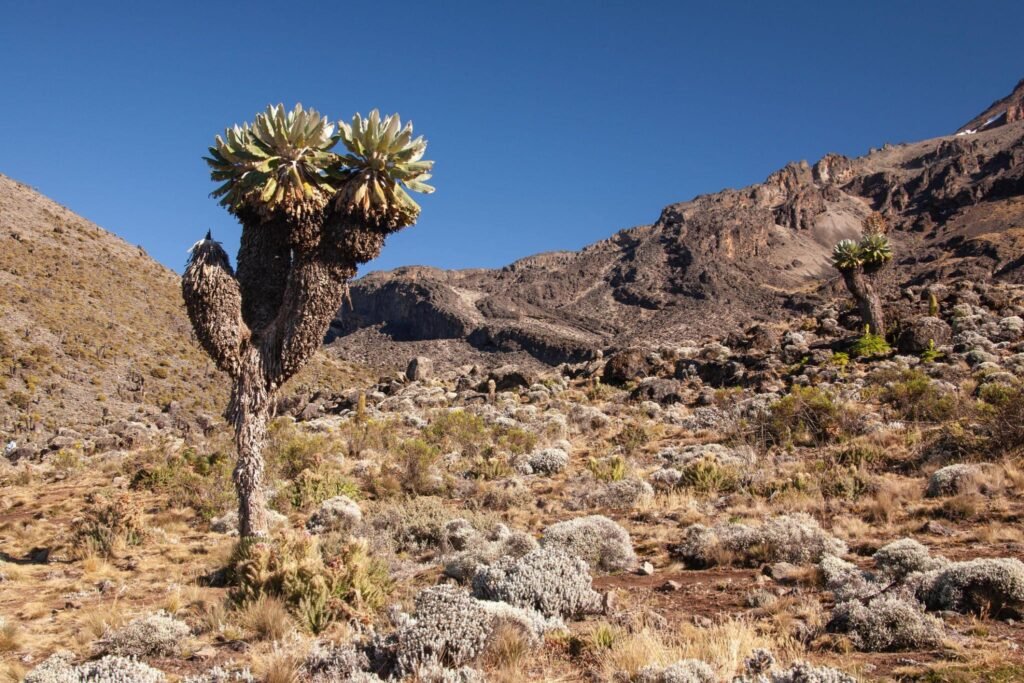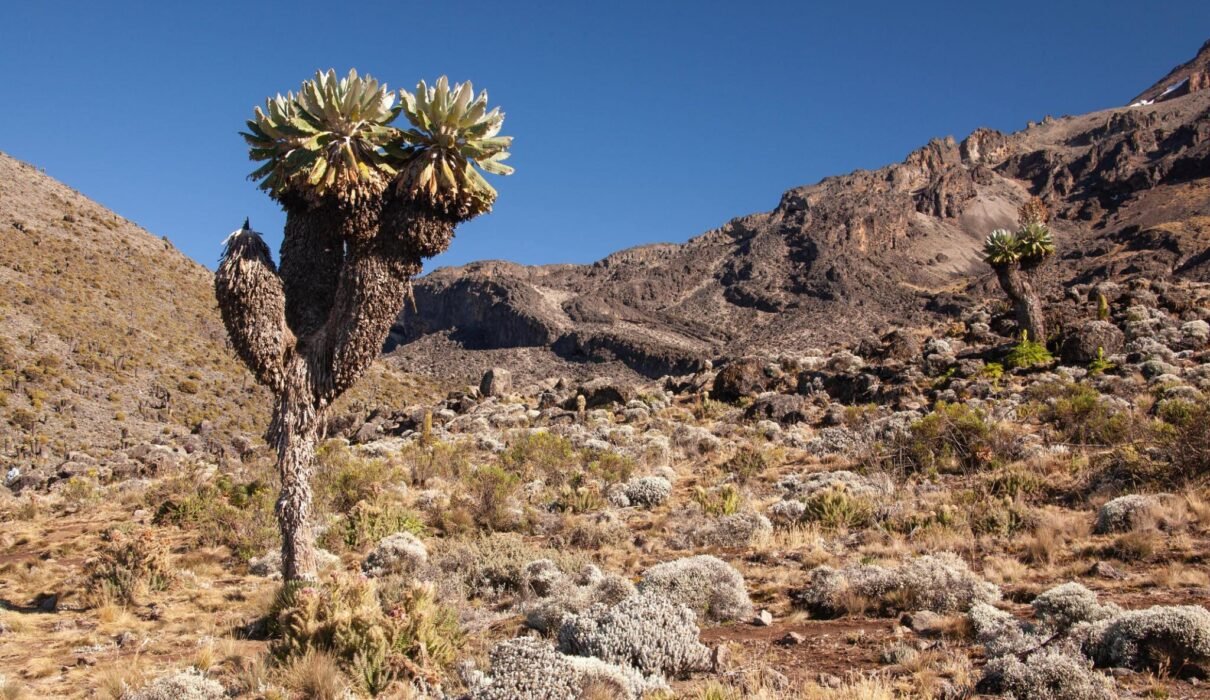The 7-Day Lemosho Route offers one of the most scenic and less crowded paths to the summit of Mount Kilimanjaro, making it the ideal route for adventurers looking for a more immersive experience. Known for its beauty and high success rate due to a gradual ascent, the Lemosho Route provides the ultimate Kilimanjaro experience, taking you through lush rainforests, vast moorlands, and alpine deserts before reaching the breathtaking Uhuru Peak at 5,895 meters.
This guide will walk you through the highlights of the 7-day Lemosho Route, outline the daily itinerary, and explain why this trek is perfect for those seeking the best of Kilimanjaro.

Why Choose the 7-Day Lemosho Route?
The 7-day Lemosho Route is renowned for offering the best balance of scenic beauty, a quieter trail, and excellent acclimatization. Here’s why the Lemosho Route stands out:
1. High Success Rate Due to Gradual Ascent
The 7-day itinerary allows for better acclimatization, thanks to its “climb high, sleep low” strategy, which significantly improves the chances of reaching the summit. This route is perfect for trekkers who want to maximize their summit success rate.
For more information on how acclimatization helps with Kilimanjaro climbs, check out Altitude.org’s guide to altitude sickness.
2. Stunning and Varied Landscapes
The Lemosho Route takes you through some of the most diverse and scenic landscapes on Kilimanjaro. From the thick rainforests at the start of your trek to the barren alpine deserts, this route offers an unparalleled view of Kilimanjaro’s ecosystems. You’ll also cross the Shira Plateau, a highlight of the Lemosho trek, which offers panoramic views of Mount Meru and the Great Rift Valley.
Learn more about Kilimanjaro’s landscapes at National Geographic’s Kilimanjaro page.
3. Fewer Crowds and a Quieter Experience
Unlike the busier Machame and Marangu routes, the Lemosho Route is less crowded, especially during the first few days. This makes it a more peaceful trek, allowing you to fully enjoy the natural beauty of the mountain without large crowds.
For more about the benefits of a quieter Kilimanjaro climb, visit Kilimanjaro Climb Specialist.
7-Day Lemosho Route Itinerary: A Day-by-Day Guide
Here’s a detailed itinerary for the 7-day Lemosho Route, designed to give you ample time to acclimatize and enjoy the scenery along the way:
Day 1: Londorossi Gate to Mti Mkubwa (Big Tree Camp)
- Elevation: 2,100 meters to 2,650 meters
- Hiking Time: 3-4 hours
- Distance: 7 km
Your adventure begins with a drive to Londorossi Gate, followed by a trek through the lush rainforests of Kilimanjaro. You’ll have the opportunity to spot wildlife like colobus monkeys and vibrant bird species as you ascend to Mti Mkubwa Camp for your first night.
For more on Kilimanjaro’s unique wildlife, visit Eddy Tours & Safaris.
Day 2: Mti Mkubwa to Shira 1 Camp
- Elevation: 2,650 meters to 3,610 meters
- Hiking Time: 5-6 hours
- Distance: 8 km
Day two takes you out of the rainforest and onto the expansive Shira Plateau, where you’ll enjoy stunning views of Kibo Peak and Mount Meru. You’ll arrive at Shira 1 Camp in the afternoon, where you can relax and take in the beautiful surroundings.
Day 3: Shira 1 to Shira 2 Camp
- Elevation: 3,610 meters to 3,850 meters
- Hiking Time: 3-4 hours
- Distance: 7 km
This is a shorter day of trekking, giving you time to acclimatize as you walk across the Shira Plateau. You’ll reach Shira 2 Camp in the early afternoon, where you’ll rest and enjoy the clear views of Kilimanjaro’s peaks.
Day 4: Shira 2 to Barranco Camp via Lava Tower
- Elevation: 3,850 meters to 4,600 meters (Lava Tower), then descend to 3,960 meters
- Hiking Time: 7-8 hours
- Distance: 10 km
Day four is an important acclimatization day. You’ll ascend to the Lava Tower (4,600 meters), where you’ll have time to rest and take in the views before descending to Barranco Camp for the night. The “climb high, sleep low” strategy helps your body adjust to the altitude, improving your chances of summit success.
For more information on the benefits of the “climb high, sleep low” approach, visit Healthline’s guide to acclimatization.
Day 5: Barranco Camp to Karanga Camp
- Elevation: 3,960 meters to 4,035 meters
- Hiking Time: 4-5 hours
- Distance: 5 km
The highlight of day five is the ascent of the Barranco Wall, a non-technical but steep climb that offers incredible views of the Karanga Valley below. After scaling the wall, you’ll continue to Karanga Camp for the night.
Day 6: Karanga Camp to Barafu Camp
- Elevation: 4,035 meters to 4,673 meters
- Hiking Time: 3-4 hours
- Distance: 4 km
On day six, you’ll hike to Barafu Camp, the base camp for your summit attempt. You’ll arrive in the early afternoon, giving you time to rest and prepare for the midnight ascent to Uhuru Peak.
Day 7: Barafu Camp to Uhuru Peak, Descend to Mweka Camp
- Elevation: 4,673 meters to 5,895 meters (summit), descend to 3,100 meters
- Hiking Time: 10-14 hours
- Distance: 17 km
Summit day begins at midnight as you make the final push to Uhuru Peak, the highest point in Africa. After reaching the summit and celebrating your achievement, you’ll descend to Mweka Camp, where you’ll rest for the night.
For more tips on what to expect on summit day, visit Kilimanjaro Climb Specialist’s summit guide.
What’s Included in the 7-Day Lemosho Route Climb?
This all-inclusive package ensures you have everything you need for a successful and enjoyable trek:
1. Experienced Guides and Porters
Your climb will be led by expert guides, certified by Kilimanjaro National Park, who will ensure your safety and success on the mountain. Porters will carry your gear, allowing you to focus on the trek.
Learn more about the importance of experienced guides at Eddy Tours & Safaris.
2. High-Quality Camping Equipment
You’ll stay in four-season mountain tents, which are designed to withstand the conditions on Kilimanjaro. All camping equipment, including sleeping mats, will be provided to ensure a comfortable experience.
3. Meals and Drinking Water
You’ll be provided with freshly prepared meals throughout the trek to keep you energized and healthy. Safe drinking water is available at each camp to keep you hydrated as you ascend the mountain.
4. Kilimanjaro National Park Fees
All required park fees, camping fees, and rescue fees are included in your package, giving you peace of mind and full access to Kilimanjaro National Park.
For more information on park regulations and fees, visit Tanzania National Parks Authority (TANAPA).
5. Safety Gear and First Aid
Your safety is our priority. The package includes oxygen tanks, first-aid kits, and pulse oximeters to monitor your health and ensure your safety at high altitudes.
How to Prepare for the 7-Day Lemosho Route Climb
1. Physical Fitness
Climbing Kilimanjaro requires good physical fitness, especially for the longer Lemosho Route. It’s important to start training several months in advance, focusing on cardio, strength training, and hiking with a weighted backpack to build endurance.
Check out this Kilimanjaro training guide for tips on preparing for the climb.
2. Packing Essentials
Packing the right gear is essential for a successful climb. Here are some key items you’ll need:
- Warm clothing layers: Including thermal layers, a fleece jacket, and a down jacket for the cold summit night.
- Sturdy hiking boots: Make sure your boots are well broken-in to prevent blisters.
- Waterproof gear: A rain jacket and waterproof pants are essential for staying dry.
- Trekking poles: These help with balance and reduce strain on your knees during the descent.
For a complete packing list, visit Ultimate Kilimanjaro’s packing guide.
Frequently Asked Questions (FAQs)
1. How difficult is the Lemosho Route?
The Lemosho Route is considered a moderate-to-difficult trek due to its length and the altitude. However, the gradual ascent and extra time for acclimatization make it one of the best routes for summit success.
2. Is the 7-day itinerary better than the 8-day option?
The 7-day itinerary is faster and suitable for climbers with good fitness levels. The 8-day Lemosho Route offers more time for acclimatization and is recommended for those who want to take a more leisurely pace.
3. What wildlife can I see on the Lemosho Route?
You may encounter colobus monkeys, baboons, and a variety of birds in the rainforest. Higher up, you’ll see unique alpine flora like giant lobelias and groundsels.
Learn more about Kilimanjaro’s wildlife at Eddy Tours & Safaris.
4. What is the best time to climb Kilimanjaro?
The best time to climb Kilimanjaro is during the dry seasons from January to March and June to October. These months offer more stable weather, making for safer and more enjoyable treks.
For more information on the best times to climb Kilimanjaro, visit BBC Weather’s Kilimanjaro guide.
5. Can I join a group climb on the Lemosho Route?
Yes, group climbs are available on the Lemosho Route. Group climbs offer a more social experience and are often more affordable than private treks.
For more information or to book your 7-Day Lemosho Route Kilimanjaro Climb, visit Kilimanjaro Climb Specialist and Eddy Tours & Safaris.

